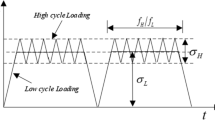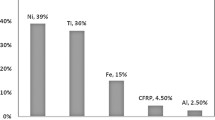Abstract
Fatigue evolution under continued stresses is a process of degradation of material performance with many uncertainties. In order to quantify the uncertainties of materials and working conditions, a probabilistic method is utilized to estimate the reliability of structures by considering scatter of the fatigue life prediction model, in which improvements are provided to model the accumulation of the damage. Firstly, the fatigue parameters are modeled by the Bayesian theory and the finite element analysis. Secondly, the distributions of parameters are transformed by the probabilistic method into the distribution of fatigue life by using the fatigue life prediction model, and a damage accumulation model is chosen to characterize regulation evolution of properties. Finally, the probability distribution function transformation approach is employed to expound distribution of fatigue damage by the known distribution of fatigue life, and a general probabilistic method is then used to estimate the reliability. By combining the above methods, the framework for reliability analysis is established and then is used to calculate the reliability for high-pressure turbine blades in a low cycle fatigue region under variable amplitude loadings.









Similar content being viewed by others
Abbreviations
- v e :
-
Elastic Poisson’s ratio
- v p :
-
Plastic Poisson’s ratio
- τ max, τ A, max :
-
Maximum shear stress on the corresponding critical plane
- τ B :
-
Shear stress on the corresponding critical plane
- σ n, max, σ max, σ B, max :
-
Maximum normal stress on the corresponding critical plane
- σ A :
-
Normal stress on the corresponding critical plane
- σ a :
-
Normal stress amplitude
- \( \sigma_{f}^{{\prime }} \) :
-
Fatigue strength coefficient
- σ y :
-
Yield strength
- Δγ max, Δγ A, max :
-
Maximum shear strain range on the corresponding critical plane
- Δγ B :
-
Shear strain range on the corresponding critical plane
- \( \Delta \varepsilon_{e} \) :
-
Elastic strain
- \( \Delta \varepsilon_{p} \) :
-
Plastic strain
- Δε A :
-
Normal strain range on the corresponding critical plane
- ε a :
-
Normal strain amplitude
- Δε max, Δε B, max :
-
Maximum normal strain range on the corresponding critical plane
- \( \varepsilon_{f}^{{\prime }} \) :
-
Fatigue ductility coefficient
- b :
-
Fatigue strength exponent
- c :
-
Fatigue ductility exponent
- \( \tau_{f}^{{\prime }} \) :
-
Shear fatigue strength coefficient
- b 1 :
-
Shear fatigue strength exponent
- \( \gamma_{f}^{{\prime }} \) :
-
Shear fatigue ductility coefficient
- c 1 :
-
Shear fatigue ductility exponent
- \( \mu_{{N_{f} }} \) :
-
Mean value of life cycles
- \( \mu_{D} \) :
-
Mean value of damage
- \( \sigma_{{N_{f} }} \) :
-
Variance of life cycles
- \( \sigma_{D} \) :
-
Variance of damage
- D :
-
Damage
- \( a \) :
-
Damage exponent
- E :
-
Young’s modulus
- G :
-
Shear modulus
- ρ :
-
Density
- \( N_{f} ,N_{f1} ,N_{f2} \) :
-
Number of cycles to failure
- \( T_{f} \) :
-
Total life
- \( S \) :
-
Applied stress
- \( k,C,m \) :
-
Material parameter
- \( \omega_{1} ,\omega_{2} ,\omega_{3} \) :
-
Rotational speed
- HP:
-
High-pressure
- FEA:
-
Finite element analysis
- FS:
-
Fatemi-Socie
- SWT:
-
Smith–Watson–Topper
- MECP:
-
Modified energy-critical plane
- MSSRP:
-
Maximum shear strain range plane
- MNSRP:
-
Maximum normal strain range plane
References
Basan, R., Franulović, M., Prebil, I., & Črnjarić-Žic, N. (2011). Analysis of strain-life fatigue parameters and behaviour of different groups of metallic materials. International Journal of Fatigue, 33(3), 484–491.
Benjamin, J. R., & Cornell, C. A. (2014). Probability, statistics, and decision for civil engineers. United States: Dover Publications.
Cui, W. (2002). A state-of-the-art review on fatigue life prediction methods for metal structures. Journal of Marine Science and Technology, 7(1), 43–56.
Echard, B., Gayton, N., & Bignonnet, A. (2014). A reliability analysis method for fatigue design. International Journal of Fatigue, 59, 292–300.
Fatemi, A., & Socie, D. (1988). A critical plane approach to multiaxial fatigue damage including out-of-phase loading. Fatigue and Fracture of Engineering Materials and Structures, 11(3), 149–165.
Fatemi, A., & Yang, L. (1998). Cumulative fatigue damage and life prediction theories, a survey of the state of the art for homogeneous materials. International Journal of Fatigue, 20(1), 9–34.
Gaspar, B., Teixeira, A. P., & Guedes, S. C. (2017). Adaptive surrogate model with active refinement combining Kriging and a trust region method. Reliability Engineering & System Safety., 165, 277–291.
Grell, W. A., & Laz, P. J. (2010). Probabilistic fatigue life prediction using AFGROW and accounting for material variability. International Journal of Fatigue, 32(7), 1042–1049.
Guida, M., & Penta, F. (2010). A Bayesian analysis of fatigue data. Structural Safety, 32(1), 64–76.
Huang, W., Garbatov, Y., & Guedes, S. C. (2014). Fatigue reliability of a web frame subjected to random non-uniform corrosion wastage. Structural Safety, 48, 51–62.
Huang, H. Z., Huang, C. G., Peng, Z., Li, Y. F., & Yin, H. (2017). Fatigue life prediction of fan blade using nominal stress method and cumulative fatigue damage theory. International Journal of Turbo & Jet Engines. https://doi.org/10.1515/tjj-2017-0015.
Ince, A., & Glinka, G. (2011). A modification of Morrow and Smith–Watson–Topper mean stress correction models. Fatigue and Fracture of Engineering Materials and Structures, 34(11), 854–867.
Jiang, T., & Liu, Y. (2017). Parameter inference for non-repairable multi-state system reliability models by multi-level observation sequences. Reliability Engineering & System Safety, 166, 3–15.
Korsunsky, A. M., Dini, D., Dunne, F. P., & Walsh, M. J. (2007). Comparative assessment of dissipated energy and other fatigue criteria. International Journal of Fatigue, 29(9), 1990–1995.
Kwofie, S., & Chandler, H. D. (2001). Low cycle fatigue under tensile mean stresses where cyclic life extension occurs. International Journal of Fatigue, 23(4), 341–345.
Li, X. Y., Huang, H. Z., & Li, Y. F. (2018a). Reliability analysis of phased mission system with non-exponential and partially repairable components. Reliability Engineering & System Safety, 175, 119–127.
Li, H., Huang, H. Z., Li, Y. F., Zhou, J., & Mi, J. (2018b). Physics of failure-based reliability prediction of turbine blades using multi-source information fusion. Applied Soft Computing, 72, 624–635.
Liu, Y., & Chen, C. J. (2017). Dynamic reliability assessment for nonrepairable multistate systems by aggregating multilevel imperfect inspection data. IEEE Transactions on Reliability, 66(2), 281–297.
Liu, C. L., Lu, Z. Z., Xu, Y. L., & Yue, Z. F. (2005). Reliability analysis for low cycle fatigue life of the aeronautical engine turbine disc structure under random environment. Materials Science and Engineering A, 395(1), 218–225.
Lv, Z., Huang, H. Z., Zhu, S. P., Gao, H., & Zuo, F. (2015). A modified nonlinear fatigue damage accumulation model. International Journal of Damage Mechanics, 24(2), 168–181.
Mahmud, M., Abdullah, S., Ariffin, A. K., & Nopiah, Z. M. (2017). Probabilistic scatter band with error distribution for fatigue life comparisons. Experimental Techniques, 41(5), 505–515.
Mi, J., Li, Y. F., Peng, W., & Huang, H. Z. (2018). Reliability analysis of complex multi-state system with common cause failure based on evidential networks. Reliability Engineering & System Safety, 174, 71–81.
Mi, J., Li, Y. F., Yang, Y. J., Peng, W., & Huang, H. Z. (2016). Reliability assessment of complex electromechanical systems under epistemic uncertainty. Reliability Engineering & System Safety, 152, 1–15.
Ni, K., & Mahadevan, S. (2004). Strain-based probabilistic fatigue life prediction of spot-welded joints. International Journal of Fatigue, 26(7), 763–772.
Rackwitz, R. (2001). Reliability analysis—A review and some perspectives. Structural Safety, 23, 365–395.
Rathod, V., Yadav, O. P., Rathore, A., & Jain, R. (2011). Probabilistic modeling of fatigue damage accumulation for reliability prediction. International Journal of Quality, Statistics, and Reliability, 2011(1), 1–11.
Sandberg, D., Mansour, R., & Olsson, M. (2017). Fatigue probability assessment including aleatory and epistemic uncertainty with application to gas turbine compressor blades. International Journal of Fatigue, 95, 132–142.
Schijve, J. (2001). Fatigue of structures and materials. Berlin: Springer.
Shang, D. G., & Wang, D. J. (1998). A new multiaxial fatigue damage model based on the critical plane approach. International Journal of Fatigue, 20(3), 241–245.
Shen, H., Lin, J., & Mu, E. (2000). Probabilistic model on stochastic fatigue damage. International Journal of Fatigue, 22(7), 569–572.
Smith, K. N., Watson, P., & Topper, T. H. (1970). A stress–strain function for the fatigue of metals. Journal of materials, 5, 767–778.
Sun, G. Q., Shang, D. G., & Bao, M. (2010). Multiaxial fatigue damage parameter and life prediction under low cycle loading for GH4169 alloy and other structural materials. International Journal of Fatigue, 32(7), 1108–1115.
Xiao, N. C., Zuo, M. J., & Zhou, C. (2018). A new adaptive sequential sampling method to construct surrogate models for efficient reliability analysis. Reliability Engineering & System Safety, 169, 330–338.
Ye, D., & Wang, Z. (2001). A new approach to low-cycle fatigue damage based on exhaustion of static toughness and dissipation of cyclic plastic strain energy during fatigue. International Journal of Fatigue, 23(8), 679–687.
Yu, H. C., & Wu, X. R. (2014). Manual of material data in engine design, the fourth volumes. Beijing: Aviation Industrial Press.
Zhang, X., Gao, H., Huang, H. Z., Li, Y. F., & Mi, J. (2018). Dynamic reliability modeling for system analysis under complex load. Reliability Engineering & System Safety, 180, 345–351.
Zhou, J., Huang, H. Z., & Li, H. (2018). A novel energy-critical multiaxial fatigue life prediction for low cycle fatigue under mixed-mode loading. Metals, 8(12), 1066.
Zhou, J., Huang, H. Z., & Peng, Z. (2017). Fatigue life prediction of turbine blades based on modified equivalent strain model. Journal of Mechanical Science and Technology, 31(9), 4203–4213.
Acknowledgements
This research was supported by the National Natural Science Foundation of China under the Contract Number 51875089. The authors would like to express special thanks to Prof. C. G. Soares at Universidade de Lisboa for his considerable help. The authors also appreciate the reviewers for their constructive comments on this paper.
Author information
Authors and Affiliations
Corresponding author
Additional information
Publisher's Note
Springer Nature remains neutral with regard to jurisdictional claims in published maps and institutional affiliations.
Rights and permissions
About this article
Cite this article
Zhou, J., Huang, HZ., Li, YF. et al. A framework for fatigue reliability analysis of high-pressure turbine blades. Ann Oper Res 311, 489–505 (2022). https://doi.org/10.1007/s10479-019-03203-4
Published:
Issue Date:
DOI: https://doi.org/10.1007/s10479-019-03203-4




